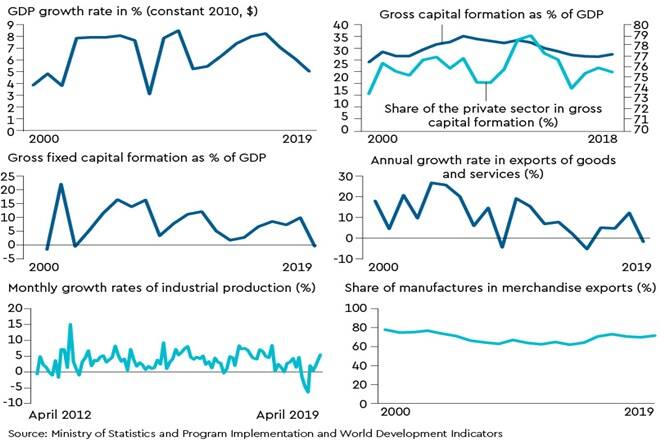Published in: Financial Express

In a recent article ‘Slogans as an Organizational Feature of Chinese Politics’, published in the Journal of Chinese Political Science, Aleš Karmazin writes that “slogans are ritually repeated elements in Chinese politics, appearing in strategic documents and main speeches.” The author highlights how leadership slogans are used for propaganda, ideological innovations, policy and strategic directions, structuring politics, and upholding unity of the ruling party. This forced me to think whether India is going the China way.
Over the past few years, leadership slogans and calls have been institutionalized in India’s politics as well, and their significance has gone far beyond motivating the citizens or supporting the ruling party to being synonymous with economic policy and strategic directions for the country.
Strategy for New India
In November 2018, the NITI Aayog released the ‘Strategy for New India @ 75’ which is founded on the clarion call given by the Prime Minister: ‘New India by 2022’. It captures three messages from the Prime Minister (as stated in the document) which include balanced development across all regions and states and across sectors along with collective effort and resolve, and effective governance. The strategy covered as many as 41 sectors for balanced growth with few strategic priorities and set the target of $4-trillion economy by 2022 (additional $1 trillion of GDP in three years). In 2019, the Prime Minister, after beginning his second term, gave a new call of a $5-trillion economy by 2024, which means the further addition of $1 trillion in 2023-24 and 2024-25.

This became a new strategic vision for policymakers even though it was not accompanied by any road-map. Recently, the Prime Minister gave yet another call of Aatmanirbhar Bharat (self-reliant India) movement supported by the ‘vocal for local’ campaign. The new slogan diverted the attention of policymakers from the vision of a $5-trillion economy to a self-reliant India and its possible interpretations. The intense debate has ensued focus on the relevance, feasibility and sustainability of ‘self-reliance’, and the vision of $5-trillion economy is relegated to the background. In a nutshell, the development policy agenda seems to be in perpetual transition with leadership slogans, resulting in numerous strategic visions, programmes, projects, campaigns and schemes, with few follow-ups.
The policy hyper-activism of this government is in compete contrast to the policy paralysis of the UPA-2. The outcome is a crowded policy landscape with multiplicity of financial inclusion programmes, and campaigns and projects including Skill India, Make in India, Start-up India, Digital India, Clean India, and so on and so forth. But what are the impacts or the final outcomes of these initiatives on the economy?
While examining the key macro indicators, one thing is clear that not only have these initiatives failed to catapult the economy to a high growth trajectory, but also could not help the economy escape the downturn. In January 2020, when the government revised GDP estimates downwards to 5% (lowest since 2009) for the year 2019-20 from 6.8%, RBI called it a cyclical slowdown rather than a structural one.
However, the secular trends depicted in the accompanying charts narrate a different story. None of the growth indicators show an upward trend. Indeed, under the Make in India initiative, India has moved to the 63rd place among 190 countries, according to the World Bank’s Ease of Doing Business 2020 report. Yet it could not be translated into increased gross capital formation as percentage of GDP or share of private investment in capital formation. The fact of the matter is that the unprecedented growth episode of 2003-04 to 2007-08 was an outcome of the global boom which India managed to leverage riding on the wave of IT outsourcing. Subsequently, the domestic stimulus pushed the economy upwards in 2010 and 2011, but the effects of these cyclical factors are not sustainable because the structural deficiencies keep pulling the economy down.
The Indian Economic Review based on India KLEMS Dataset
A recent study by Goldar et al published in the Indian Economic Review based on India KLEMS Dataset shows acceleration in total factor productivity (TFP) growth to 1.8% per year over a decade-long period of 2003-14 and attributes it to acceleration in the rate of TFP growth achieved by manufacturing, services and agriculture sectors, in that order. These achievements should have been reflected in improved capital formation, industrial production and/or export performance. However, the secular monthly growth trends in industrial production and the share of manufactures in total merchandise exports do not quite conform to the findings.
It is high time the government adopted a well-informed policy approach based on a well-crafted strategic framework rather than populist leadership slogans. The strategic framework should involve not only a vision, but also objectives, targets and strategic approach underpinned by strategic tools, time frames, and implementation and monitoring and evaluation strategies. In my view, the only route to a $5-trillion economy or balanced growth across sectors and regions or even self-reliant India is through competitiveness and inattentiveness. We need to identify our manifested and latent competitive strengths, set our priorities and identify the tools with a focus on competitiveness. The Southeast Asian countries, for instance, have adopted a high-density agglomeration approach to target Industry 4.0 through export-oriented industrialization, which they are prepared to leverage to grab most US FDI diverted from China. Further, the programmes, projects and campaigns should be critically assessed and evaluated on the basis of factual evidence and reliable statistical data which is made accessible to the general public. However, monitoring and evaluation is worthwhile only to the extent it is actually used by decision-makers for follow-up actions. To ensure this, monitoring and updating the status of evaluation follow-up actions must be mandated.

